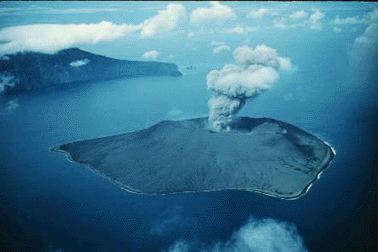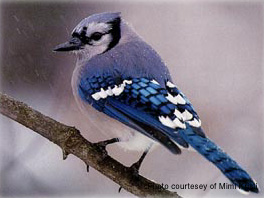Colonization of Vacant Habitat
Frugivorous birds and mammals may also carry seeds into 'vacant' areas where seedlings and young plants do not have to compete for light and nutrients with as many adult plants or juveniles or where light and nutrient levels are simply greater than areas near their parents. There are two well-documented examples of how frugivores have brought seeds into vacant areas in the past resulting in the creation of new forests: the Krakatau Islands in Indonesia and oak and beech forests in North America.

2 week old seedling of Endiandra sieberi in open
habitat, Queensland, Australia
Krakatau Islands
In 1883 a volcanic eruption on the former island of Krakatau resulted in the reformation of land creating 3 large islands that had been completely sterilized of all flora and fauna (Whittaker and Jones 1994). Biologists made repeated visits to these islands to survey their recolonization by plants and animals. After an initial period where island slopes were covered in grassland, forest now covers much of these islands. In all, over 134 fleshy-fruited plant species have been brought to the islands by frugivorous birds and bats across a minimum ocean crossing of 12 km (Whittaker and Jones 1994).

Anak Krakatau, an island formed after 1927 by
continuing volcanic eruptions. Forest has yet to develop on this island
because of continuing eruptions.
Blue Jays and the Ice Age
 Blue Jay's may have been responsible for the rapid
spread north of oak and beech tree species after the end of the last Ice
Age in North America.
Blue Jay's may have been responsible for the rapid
spread north of oak and beech tree species after the end of the last Ice
Age in North America.
While North American oak and beech trees (Quercus spp. and Fagus spp.) do not have fleshy-fruit, they do produce fat and protein-rich nuts that are avidly consumed by many birds and mammals. Because these plant species produce nut crops synchronously in huge crops many consumers attempt to store the nuts so that they will have a supply after plants have ceased bearing nut crops. Because animals forget the locations they stored things (much the way people forget where their car keys are) nuts often go unconsumed and germinate and grow from the locations they were stored.
Blue Jays (Cyanocitta cristata), a North American jay species, are known to carry seeds of these plants between several hundred meters to 4 kilometers at a time before burying them in the ground, often in suitable sites for germination (Johnson and Webb 1989).
At the end of the last Ice Age, 18,000 years ago oaks and beeches were only found in the southern US with ice extending across most of the central and northern states and Canada. Pollen data suggests that oak and beech species spread north as the ice sheets receeded at rates of 2 - 3.5 km per decade (Davis 1981)!
This spread was most likely achieved through the nut dispersal and caching proclivities of the Blue Jay mentioned above, as other tree species that did not have nuts as palatable to bird advanced at much slower rates (Johnson and Web 1989).